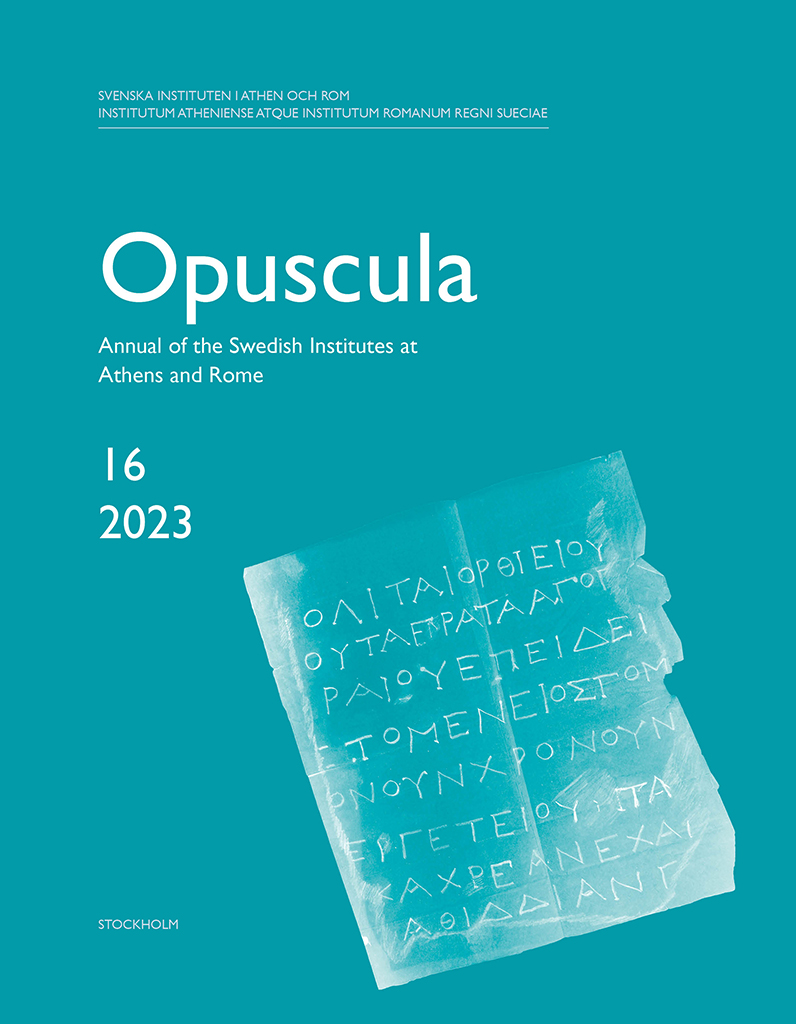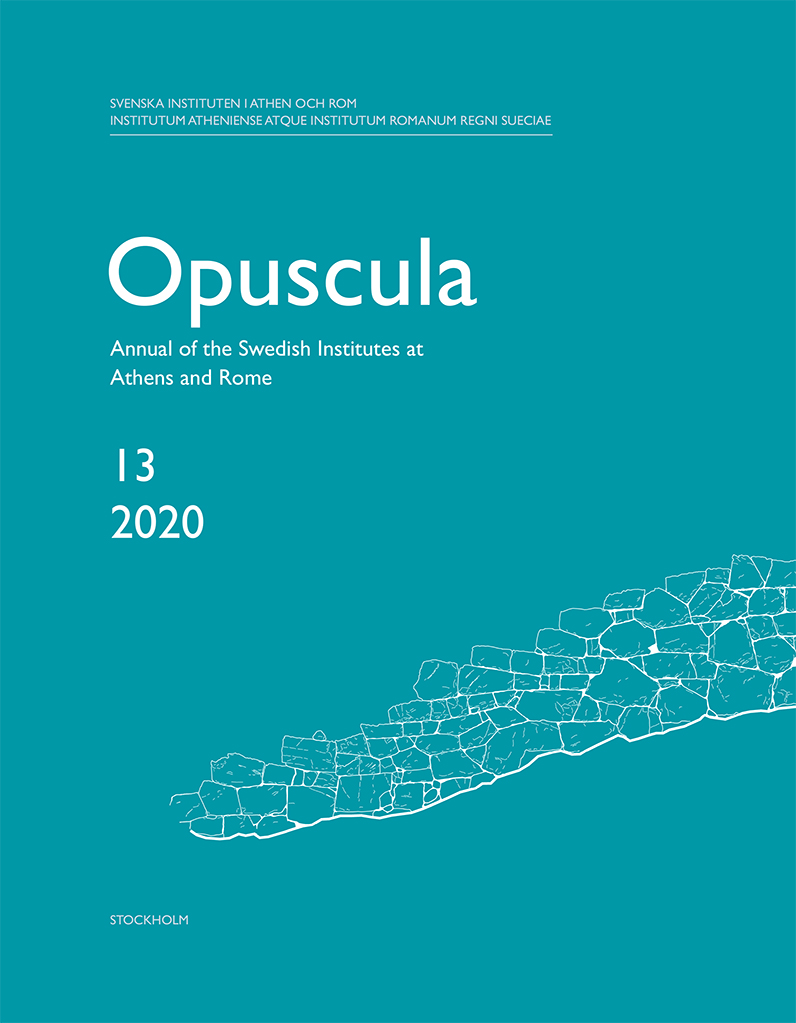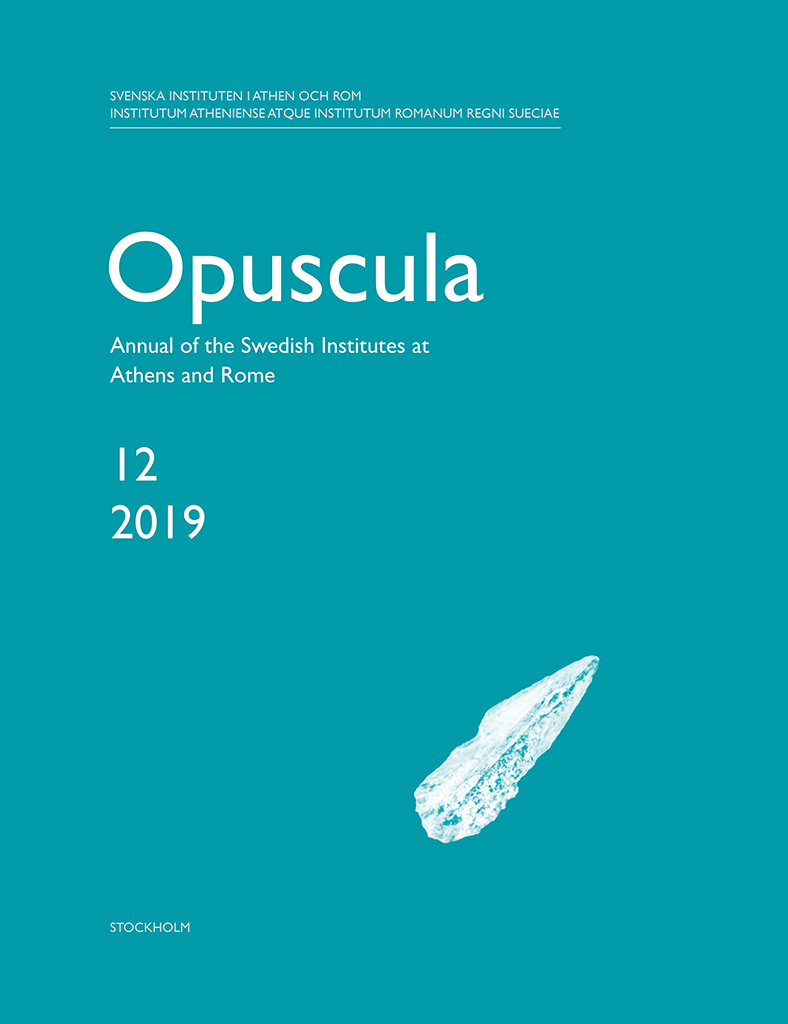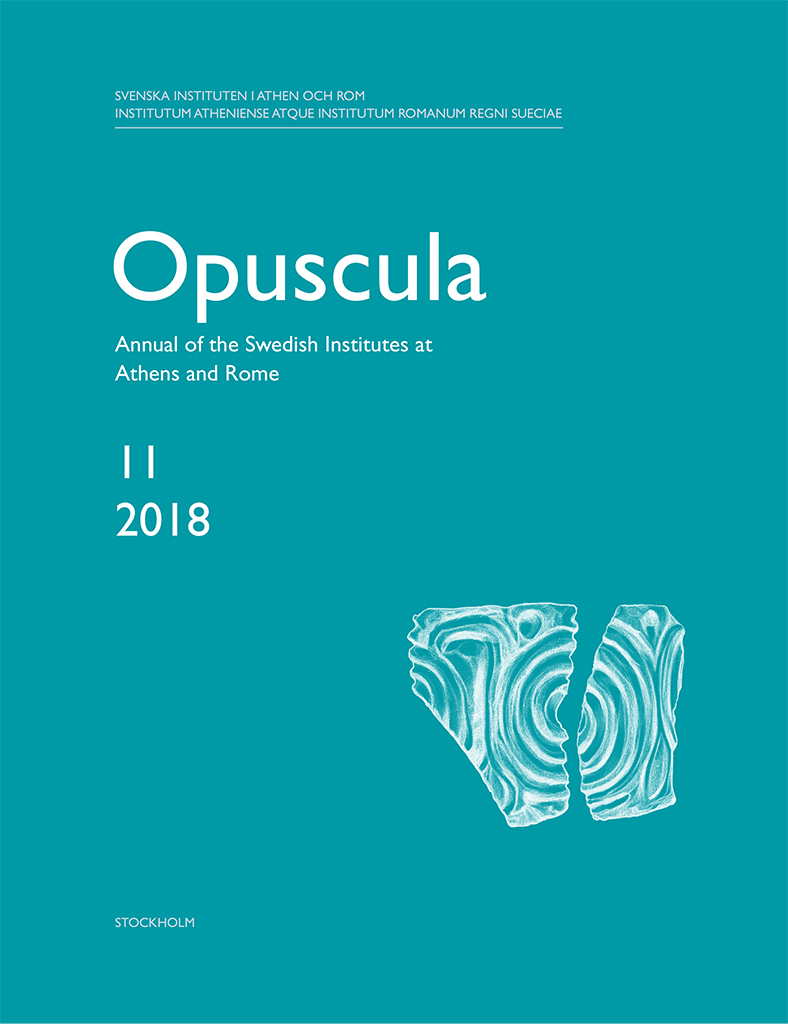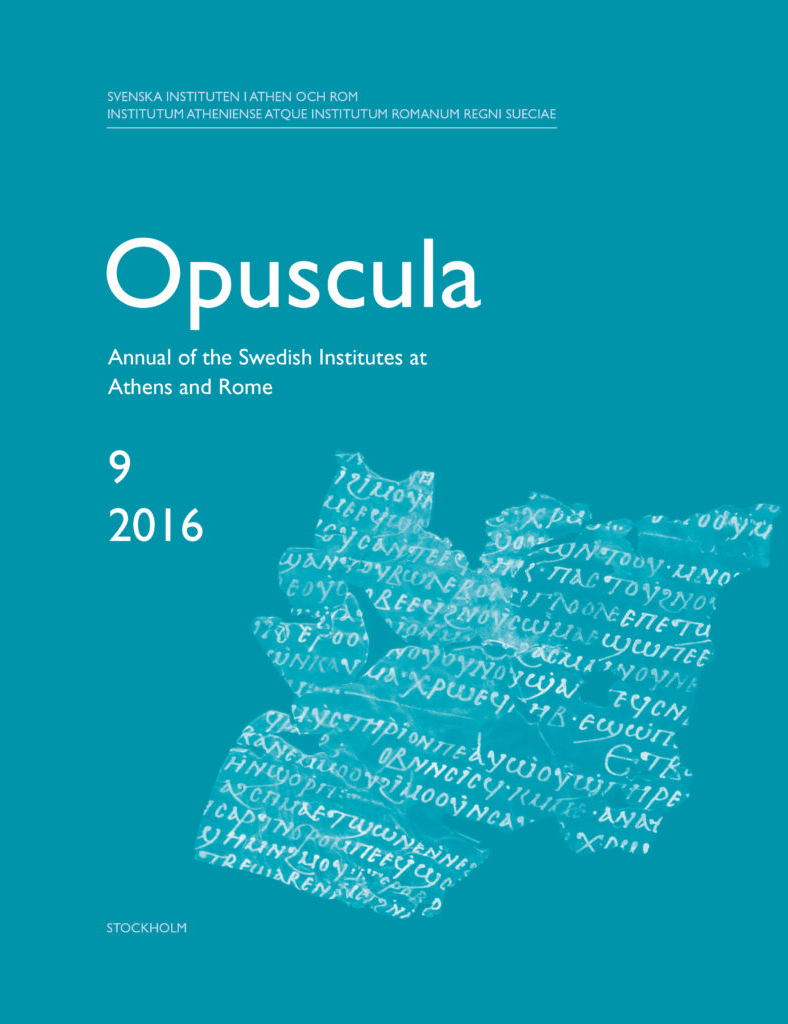Opuscula is published by the Swedish Institutes at Athens and Rome, with the aid of a grant from the Swedish Research Council. Distributed by Eddy.se AB. View journal at ERIH PLUS. All content available with open access. The New Swedish Cyprus Expedition (The Söderberg Expedition): Excavations at Hala Sultan Tekke autumn 2021 and spring 2022. Preliminary results By Peter M. Fischer & Teresa Bürge with contributions by Rainer Feldbacher, Kirsi O. Lorentz, Bianca Casa, Natalie M. Branca, Yuko Miyauchi, Sila Kayalp, Maria Nectaria Antoniou, Svetlana Gasanova, Valentina Vassallo, Rahaf Orabi, Panagiotis Ioannou & Sorin Hermon Abstract In 2021 and 2022, the 13th and 14th seasons of excavations at the Late Bronze Age site of Hala Sultan Tekke were carried out in Area A, and as a result of these investigations numerous tombs were found. These tombs were threatened by farming. Four magnetic anomalies, indicated in the 2017 survey magnetometer map, were investigated. They represent three tombs, L198, TT, and UU, and the probable Offering Pit SS-S. The minimum number of individuals (MNI) in Pit Tomb L198, which contains only secondary burials, is six. They are associated with 21 ceramic vessels of which a few were imported from Anatolia. Chamber Tomb TT was completely excavated and contained a minimum…
Opuscula is published by the Swedish Institutes at Athens and Rome, with the aid of a grant from the Swedish Research Council. Distributed by Eddy.se AB. View journal at ERIH PLUS. All content available with open access. The New Swedish Cyprus Expedition (The Söderberg Expedition): Excavations at Hala Sultan Tekke 2020 and 2021. Preliminary results By Peter M. Fischer & Teresa Bürge, with contributions by B. Placiente Robedizo, C. Eriksson, K.O. Lorentz, N.M. Branca, B. Casa, Y. Miyauchi, S.A.M. Lemmers, S. Kayalp, V. Vassallo, S. Florindi, S. Gasanova, S. Hermon, L. Avial Chicharro, E. Peri & B. Clark Abstract In 2020 and 2021, the eleventh and twelfth seasons of excavations at the Late Bronze Age city of Hala Sultan Tekke were carried out in the cemetery of Area A. Based on indications provided by a large-scale magnetometer survey, two tombs exposed by intensive farming were located, Tombs RR and SS. The excavation of Tomb RR, which had started in 2018, was concluded. The total minimum number (MNI) of skeletons in this tomb, of which most were incomplete and disarticulated, is estimated at 137. In addition to clay figurines, seals and scarabs, objects of ivory, as well as jewellery of gold, silver,…
Opuscula is published by the Swedish Institutes at Athens and Rome, with the aid of a grant from the Swedish Research Council. Distributed by Eddy.se AB. View journal at ERIH PLUS. All content available with open access. The New Swedish Cyprus Expedition 2019: Excavations at Hala Sultan Tekke (The Söderberg Expedition). Preliminary results, with contributions by L. Recht, B. Placiente Robedizo, C. Eriksson, L. Andersson, M. Svensson, L. Avial Chicharro, S. Hermon, M. Polig & D. Kofel By Peter M. Fischer (University of Gothenburg, Sweden) & Teresa Bürge (Austrian Academy of Sciences) Abstract The tenth season of excavations at the Late Bronze Age city of Hala Sultan Tekke was carried out in four areas: City Quarter 1 (CQ1), CQ4, City Wall 1 (CW1), and Area A (Tomb RR). The excavations in CQ1 provided additional information on the pre-LC IIIA occupation of the city. Stratum 3 which can be dated to the LC IIC (13th century BC) was further exposed. For the first time in the city even older phases, Strata 4 and 5, were found. These are tentatively dated to the LC I–II (15th to 14th century BC). In CQ4 numerous storage areas were exposed, which belong to a large…
Opuscula is published by the Swedish Institutes at Athens and Rome, with the aid of a grant from the Swedish Research Council. Distributed by Eddy.se AB. View journal at ERIH PLUS. All content available with open access. The New Swedish Cyprus Expedition 2018: Excavations at Hala Sultan Tekke (The Söderberg Expedition). Preliminary results, with contributions by J. Tracz and D. Kofel By Peter M. Fischer (University of Gothenburg, Sweden) & Teresa Bürge (Austrian Academy of Sciences, Austria) Abstract During the ninth field season at the Late Bronze Age city of Hala Sultan Tekke, excavations in City Quarter 1 (CQ1) continued and brought to light industrial and domestic structures belonging to three phases of occupation (Strata 3–1) dating to the 13th and 12th centuries BC (LC IIC–IIIA). Finds of more than half a ton of copper slag together with remains of furnaces and tuyères indicate intensive urban copper production. There is also evidence of textile production in CQ1. A magnetometer survey of roughly 23 ha resulted in the discovery of another large city quarter (CQ4) between CQ1 and Area A (the cemetery) with regularly arranged stone-built compounds of imposing dimensions intersected by streets. Several massive walls are faced with ashlar slabs…
Opuscula is published by the Swedish Institutes at Athens and Rome, with the aid of a grant from the Swedish Research Council. Distributed by Eddy.se AB. View journal at ERIH PLUS. All content available with open access. The New Swedish Cyprus Expedition 2017: Excavations at Hala Sultan Tekke (The Söderberg Expedition). Preliminary results By Peter M. Fischer (University of Gothenburg) & Teresa Bürge (Austrian Academy of Sciences). With contributions by Magda Ausiayevich, Bebelyn Placiente Robedizo, Victor Barrera Alarcón, Laerke Recht & Dominika Kofel. Abstract During the eighth field season at the Bronze Age city of Hala Sultan Tekke, excavations in City Quarter 1 (CQ1) exposed massive industrial and domestic structures belonging to three phases of occupation (Strata 3–1) dating to the 13th and 12th centuries BC (LC IIC–IIIA). Georadar survey, penetrating to a maximum depth of approximately 1 m, guided the excavation of walls of Strata 1–2, both of which were destroyed by conflagration. Excavations 1.5–2 m below the surface and also below the maximum penetration depth of the radar revealed a heretofore buried phase of occupation with substantial architectural units. For the first time, massive Stratum 3 structures with a markedly different building technique were exposed. Copper smelting installations,…
Opuscula is published by the Swedish Institutes at Athens and Rome, with the aid of a grant from the Swedish Research Council. Distributed by Eddy.se AB. View journal at ERIH PLUS. All content available with open access. The New Swedish Cyprus Expedition. Excavations at Hala Sultan Tekke (The Söderberg Expedition). Preliminary results By Peter M. Fischer & Teresa Bürge. With contributions by Laerke Recht, Dominika Kofel, David Kaniewski, Nick Marriner & Christophe Morhange Abstract In the seventh season at the Bronze Age city of Hala Sultan Tekke excavations continued in City Quarter 1 (CQ1) where georadar indicated stone structures to the south of the area excavated in 2010–2012. Massive domestic structures, which belong to three phases of occupation (Strata 1–3), were exposed. Both the most recent Stratum 1, and Stratum 2 were destroyed in a conflagration. The three phases are preliminarily dated to the 13th and 12th centuries BC. Excavations were also carried out in Area A, roughly 600 m to the south-east of CQ1. Seven circular anomalies indicated by our geomagnetic survey were excavated. Two were pits of modern date, and three were identified as Late Cypriot wells. Another anomaly turned out to represent a rich Late Cypriot offering…
Opuscula is published by the Swedish Institutes at Athens and Rome, with the aid of a grant from the Swedish Research Council. Distributed by Eddy.se AB. View journal at ERIH PLUS. All content available with open access. The New Swedish Cyprus Expedition 2015. Excavations at Hala Sultan Tekke. Preliminary results By Peter M. Fischer & Teresa Bürge. With a contribution by Dominika Kofel Abstract In 2015 the sixth season of the renewed excavations at the Bronze Age city of Hala Sultan Tekke continued in the compound which was exposed in Area 6W in 2013–2014. Further evidence of textile processing was found. The results of another ground-penetrating radar (GPR) survey in 2014 indicated a new city quarter west of the former. Excavations were initiated there in 2015 and parts of the remains of a large compound were exposed. Two occupational phases, Strata 1 and 2, could be determined, both of which were destroyed in a conflagration. Further excavations were carried out in Area A, 550 m to the east of Area 6W and close to the mosque of Hala Sultan Tekke. In 2014 more than 80 circular anomalies were indicated by our geomagnetic survey supported by GPR. Twelve of them were…
Opuscula is published by the Swedish Institutes at Athens and Rome, with the aid of a grant from the Swedish Research Council. Distributed by Eddy.se AB. View journal at ERIH PLUS. All content available with open access. The Swedish Jordan Expedition 2014 at Tall Abu al-Kharaz. Preliminary results from Areas 12 and 13 By Peter M. Fischer & Teresa Bürge Abstract In previous seasons excavations have concentrated on the periphery of the city of Tall Abu al-Kharaz, a multi-period tell in the Central Jordan Valley. Tall Abu al-Kharaz flourished from the Early Bronze to Islamic times, from roughly 3200 BC to the 10th century AD. The main object of the field work in 2014 was to investigate the area around the geographical centre of the city (Area 12). Preference was given to further investigation of the Iron Age sequence, i.e. the period from the 12th to the 7th centuries BC (local Phases IX–XV). Another task was to extend the excavations in the northern part of the city, Area 7, which produced essential information on the Iron Age, towards the south (Area 13) in order to generate a coherent picture of Iron Age occupation in the city’s northern half. Domestic structures…
Opuscula is published by the Swedish Institutes at Athens and Rome, with the aid of a grant from the Swedish Research Council. Distributed by Eddy.se AB. View journal at ERIH PLUS. All content available with open access. The New Swedish Cyprus Expedition 2014. Excavations at Hala Sultan Tekke. Preliminary results. By Peter M. Fischer & Teresa Bürge. With contributions by B. Stolle, I. Trinks, L. Mazzotta, L. Recht, A. Lindqvist & D. Kofel. Abstract The initial aim of the project—the search for the oldest city of Hala Sultan Tekke—continued in 2014. Geophysical methods were used, which led to the discovery of new city quarters, and a broadening of the research objectives, to include revealing the total extent of the city. The GPR survey indicated a huge stone compound of at least 50 m × 40 m to the west of a probable street. Excavations continued in Area 6 West, where in 2013 a domestic and industrial compound was excavated as part of a hitherto unknown city quarter. The 2014 field work exposed stone-built structures and rich find contexts with locally made and imported pottery, numerous tools and several items of gold and silver jewellery. The violent destruction of the most…
Opuscula is published by the Swedish Institutes at Athens and Rome, with the aid of a grant from the Swedish Research Council. Distributed by Eddy.se AB. View journal at ERIH PLUS. All content available with open access. The Swedish Jordan Expedition 2013 at Tall Abu al-Kharaz. Preliminary results from Areas 9, 10 and 11 By Peter M. Fischer & Teresa Bürge Abstract The Swedish excavations at Tall Abu al-Kharaz, a twelve-hectare tell in the central Jordan Valley, continued in 2013 in order to shed further light on the Iron Age occupation of this city that was first settled around 3200 BC, corresponding to the conventional Early Bronze Age IB. The Iron Age occupation lasted from the 12th century BC until 732 BC, when the city was conquered by the Neo-Assyrians. From 2009 to 2012, excavations in Area 9 revealed an exceptionally well-preserved two-storey compound dating from Iron Age I (local Phase IX), i.e. around 1100 BC. The stone compound was exposed for a length of 46 m. It consists of 21 rooms, with walls still standing to a height of more than 2 m. Several hundred complete vessels and other objects point to the extensive contacts of a fairly rich…

